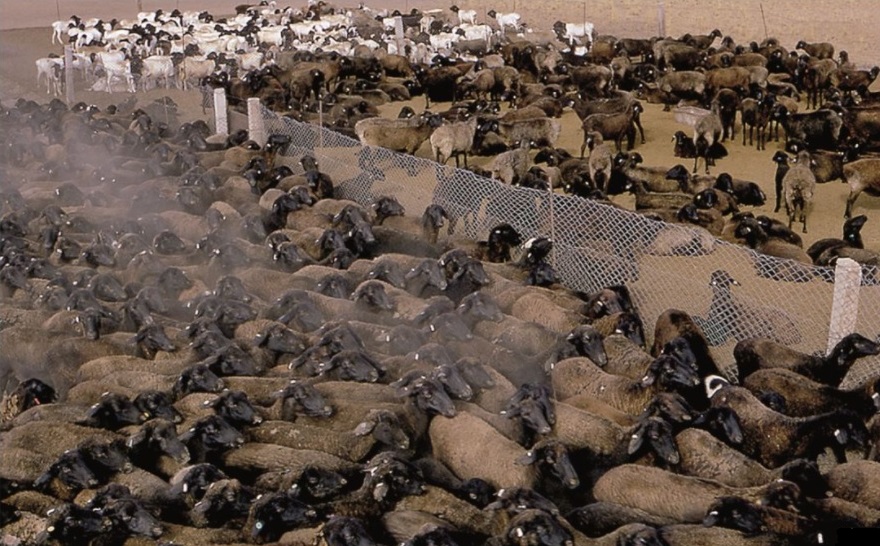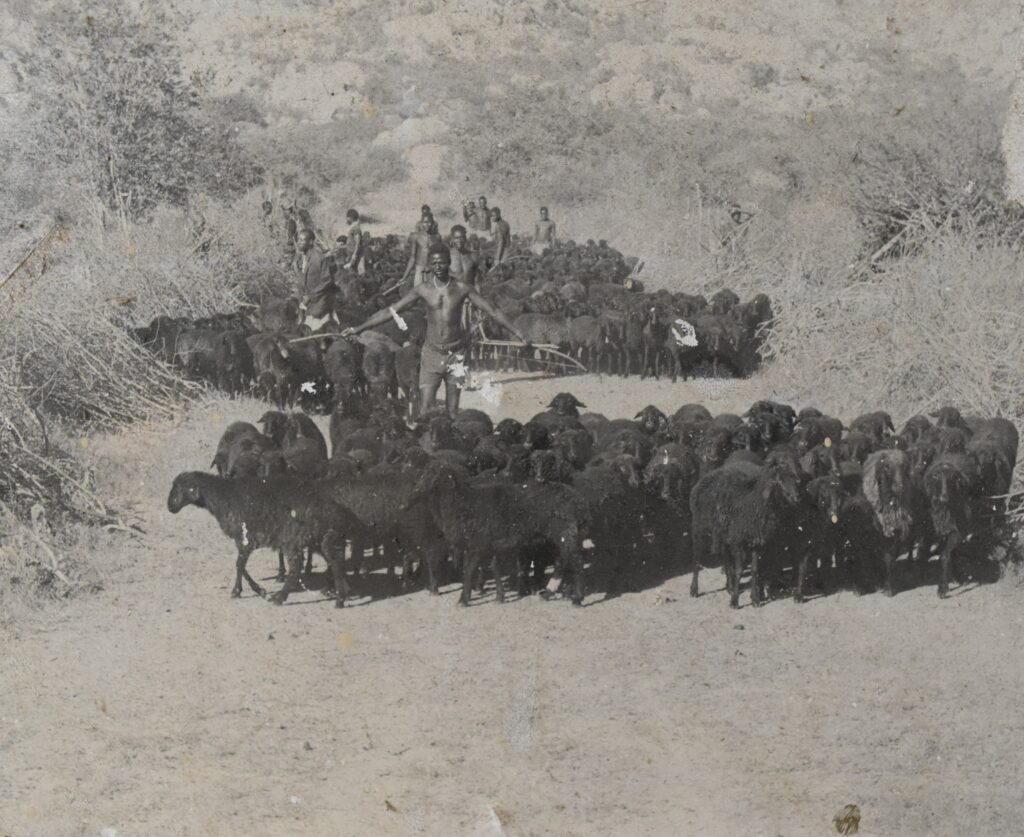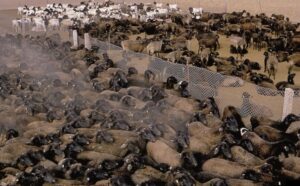By: Bernard C. Moore (Michigan State University)
ORIGINALLY PUBLISHED 9 APRIL 2021 [LINK TO ORIGINAL]
CONTINUED FROM PART ONE [LINK]
Last week, I discussed the importance of Angolan contract workers hired through SWANLA (the South West Africa Native Labour Association) in meeting labour demands on karakul sheep farms in southern Namibia. Angolans made up more than 40% of the contract labour force up through 1970, and they were sent disproportionately to farms, rather than mines. During the late 1940s and early 1950s, however, economic changes in the south of Angola were threatening the flow of labour to white-owned farms in Namibia, which deeply worried the administration.
Smuggling Sheep
We now turn to our third and final ‘thread’ concerns these changes in southern Angola during the 1950s. We all know about some of the main industries in this region, particularly fishing and iron mining. I was surprised, however, when I found a series of police reports in the National Archives of Namibia (NAN) concerning elaborate smuggling operations between Namibia and Angola: not of workers this time, but of karakul sheep. A large number of farmers in Outjo district would arrange with Portuguese buyers on the Angolan side to pay top-dollar for smuggled karakul rams, as the export of karakul sheep was banned since the promulgation of the Karakul Industry Protection Ordinance of 1930. While most of these operations involved clandestine midnight drives through today’s Omusati region, the most extreme was that of Chris Brand, a Kamanjab farmer. Brand was an amateur pilot, and he would fly to a private farm near Mariental where he would purchase as many rams as he could fit in his small aeroplane. He would then refuel and fly to Angola, where he was able to triple his money; these bi-weekly trips quickly paid off the loan for his aeroplane.
But who was Brand selling to? Answering this question involved pulling more on this thread. A number of other colonial powers – French, Italian, Portuguese, and British – were entranced with the success that Namibia had with its karakul sector during the 1940s and 1950s; the hardiness of the sheep seemed to have the power to put unproductive lands to good use (at least from the colonialists’ perspective). A number of farms in Namibia which were surveyed in the 1940s for white settlement – particularly those areas along the Namib intended for WWII veterans – were explicitly intended for karakul farming and nothing else. The then-Department of Agriculture and the Lands Branch understood that cattle and most other breeds of sheep would not succeed in these arid areas like karakul would. The gamble ultimately proved correct, and a number of extremely arid Namib-desert farms with telling names like Wereldend, Vergenoeg, and Grens became productive karakul farms. The other European powers tried to mimic this. The Italians tried to buy Namibian karakul rams to facilitate white settlement in the desert areas of Libya; the French tried to buy them for the same reason in Chad; but the most determined were the Portuguese in Angola.
A Portuguese Experiment
Now, Moçâmedes District in the southwest of Angola is not so different from much of Namibia; the region receives between 200-400mm of rainfall each year, and the Namib desert even continues along the coast for a few hundred kilometres into Angola. During the Portuguese times, the colonial administration tried to settle this semi-arid zone with whites, as it didn’t have malaria or other endemic diseases which inhibited non-coastal settlement in other parts of the country. It was decided that karakul farming would be the vanguard for Portuguese settlement in Moçâmedes District. In 1947, the Governor-General allocated nearly 8 million hectares of land in Moçâmedes, Huíla, and Cunene Provinces for inclusion into the Reserva Pastoril do Caracul, in which land would be allocated gratis to white settlers intending to engage in commercial farming of karakul sheep. The following year, he hired a team of veterinarians to run the Posto Experimental do Caracul, which was modelled off of Namibian proefplase like Gellap-Ost and would provide technical services and training to the incoming settlers. The Posto would also provide rams to the settlers, as well as artificial insemination services.

But allocating land and hiring veterinarians does not create a sheep farming sector; one must actually have the sheep. While the Posto was able to purchase some flocks from the United States and Germany, the vast majority of their karakul sheep was smuggled overland (or by aeroplane) from Namibia. The two chief veterinarians, M. dos Santos Pereira and E.V. Martins, tapped into old connections, calling on the so-called Angola-Boers to (1) help with smuggling the sheep, and (2) to eventually take up residence within the Reserva. Some, such as the Outjo-based N.J. van Rensburg (who was born in Angola), heeded the call and was smuggling rams on a bi-weekly basis via lorry to Martins and Pereira. While the quantity of purebred sheep in Angola was low compared to Namibia – and the Portuguese were not able to breed the so-called watersy pelt which was making Swakara a global brand – their industry was developing slowly but surely. And since the Reserva was a mixed farming area, those settlers who struggled to obtain karakuls were still able to farm with cattle.
Angolan Karakul
During university, my history lecturer gave me a piece of advice which I haven’t forgotten: ‘never write about a place you have not seen with your own eyes; you cannot do it justice’. Fast forward to 2019, I’m boarding a TAAG Airlines flight from Windhoek to Lubango to finally see the remnants of Angola’s karakul industry with my own eyes. I met up with an Angolan friend of mine who would translate for me (I can read Portuguese a bit, but I can’t speak it to save my life), and we drove west. As one descends from the fertile Huíla Plateau into the more semi-arid Moçâmedes Province, the vegetation and landscape looks much more like Namibia, and agriculture moves from vegetable and grain plantations to pastoralism. About 120km west of Lubango lies the now-sleepy town of Caraculo, inhabited by 2,000-3,000 people. It has a service station, a few shops, and most importantly a government veterinary training centre, now called the Estação Zootécnica do Caraculo.
We had arranged our visit several weeks before, which had enabled the present chief veterinarian, Dr. Francisco Felgueiras, to track down some of the retired former employees of the old Posto during the Portuguese days. In my conversations with Felgueiras and the former employees, I learned the other reason why white karakul farmers in Namibia felt so threatened by Portuguese sheep farming in Angola: the shepherds, shearers, and farm labourers were recruited by Portuguese officials from the area near modern-day Ondjiva, Cunene province. The majority were Oshikwanyama-speakers, and large numbers of them had previously signed SWANLA contracts to work as shepherds in Namibia, where they had learned about karakul. Many of them took up work as karakul shepherds in the Reserva because the Portuguese allowed contract workers to bring their wife and children with them, providing family housing – something which was not permitted under SWANLA.

During the 1950s-60s, the Namibian karakul industry was in conflict with their Portuguese counterparts in Angola not just because the northward smuggling of rams threatened Namibia’s place in global pelt markets, but also because the development of Angola’s karakul sector threatened the southward smuggling of Angolan shepherds and the ability of white farmers to access cheap labourers who had little ability to desert poor working conditions.
Next week, we will conclude this story by looking at the methods which the then-SWA Administration took to make the agricultural sector less reliant on both long-distance contract labour and local labour, as well as the effects of these policies on the labourers themselves.
CONTINUTED WITH PART THREE [LINK]
